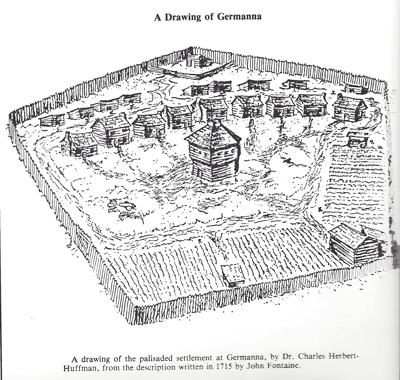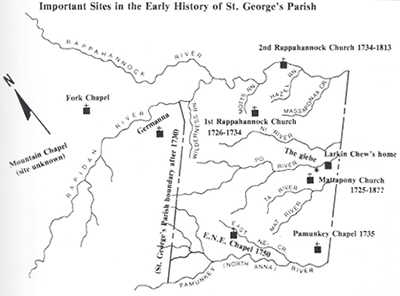By Debbie Haliday
BACKGROUND
It was customary for the Church of England to provide for the religious needs of settlers in a new land.
The government consisted of the House of Burgesses (The General Assembly elected by the people) and the Governor and King’s Council (appointed by the King). At the time of Alexander Spotswood’s tenure as Lt. Governor, the King’s Council had one Anglican clergyman who is described by Paula Felder as “scurrilous”. The General Assembly established counties and parishes, legislated for the established church, supported it through taxation and protected it against competition.
EARLY ST. GEORGE’S PARISH – 1712-1775
The issues of note during this period dealt with a lay baptism, church attendance, location of churches in the very large St. George’s Parish….and of course – money. The legal tender at this time was tobacco.
Alexander Spotswood was appointed the Lt. Gov of Virginia in 1710. As Lt. Governor, Spotswood was able to have a far reaching impact on the colony, especially the formation of St. George’s Parish. Over a short period of time he and his partners acquired large tracts of land.
The General Assembly created St. George’s Parish in 1714. However; in 1720 the General Assembly repealed the law creating the 1714 parish and created a new St. George’s Parish.
In 1720 Spotswood created a new county (Spotsylvania). The county and the parish had the same boundaries and was very large as it extended over the mountains. Why so unusually large? The governor wanted to check the French advance into the Ohio River Valley and protect the parish-county against the Native Americans who were being pushed farther and farther into the mountains. All the inhabitants in the county(parish) were freed of public levy for 10 years. Spotswood seemed to be more interested in his “land grabs” than establishing Anglicanism in St. George’s Parish.
GERMANNA – 1721 – THE LOCATION OF THE SEAT OF JUSTICE.
When the county-parish was designated, an appropriation of 500 pounds was made for a church, a courthouse, a prison, a pillory and stocks (supply of salable goods).The first Vestry was organized and met in the spring of 1723.

The first court sat in August, 1722. There were six justices. At least three were church vestry members. In 1724 the case of the lay baptism of Ann Alsop was brought before the court. Lay baptisms were permitted in cases of emergency by the Anglican Communion and were possible in 1724. However, churchwarden Thomas Chew gave information to Larkin Chew who“committed” (stated that this lay baptism was illegal) a Thomas Mosely and John Shelton. They gave bond and security for their good behavior.
However, they failed to appear at the next court and were ordered to be committed to jail and receive 31 lashes on their bare backs…16 in the evening and 15 the next morning.
There were also 13 “presentments” by the grand jury of absentees from public worship. However, at this time public opinion supported the “rights of conscience”. The only case brought to execution during this court was one absence from public worship. John Diggs was fined 10 shillings or 100 lbs of tobacco or receive corporal punishment. So much for these rules of behavior for parishioners of the Anglican Communion.
ISSUE OF THE VESTRY MINUTES
The first meeting of St. George’s Parish of which we have a RECORD was held in June 1726. At that time the parish had its first Anglican cleric. There were eight vestry members, three of whom were also justices at the first court held at Germanna in August 1722.
John Minor who was elected to the vestry in 1805 looked up the early vestry minutes. He found that the recorded minutes started in 1726. There were no minutes from 1722-1726. He stated that those records had been “mutilated”..i.e. the proceedings had been torn out of the book.
ISSUES OF LOCATION OF CHURCHES AND FUNDING

In 1732 the people of Fredericksburg burned down the “church” in Germanna because it was “too far away”.
In 1732 church warden, Henry Willis (who was the third husband of George Washington’s aunt, Mildred Washington) was designated to build two churches for 150 pounds – one in Fredericksburg and one in Mattapony. The Governor halted construction of the churches because the southern inhabitants of the parish protested the location of the two churches.
At a hearing of the King’s Council in 1733, it was decided that the southern inhabitants should have filed their protest before construction started. The Council authorized the parish to proceed. Neither church was completed. Colonel Willis died. The unfinished church is Fredericksburg was used for services in 1734.
In 1741 the vestry threatened to sue Col Willis’ executors if the two churches were not completed by June 30, 1741. Our first church in Fredericksburg was completed after seven years of construction.
Carrole Quenzel writes” that the Established Church of VA belonged to the people and not to the King or to the royal government.”
ANGLICAN CLERGY IN THE EARLY PARISH
A subsidy (the King’s Bounty-20 lbs.)was granted to rectors settling in America.
The first rector of St. George’s Parish to receive the King’s Bounty was given to Rev. Theodoses Staige. In 1726 Staige took charge of St. George’s Parish with an annual salary of 16,000 pounds of tobacco ( the legally established stipend for Anglican clerics in Virginia. He also received board and expenses in lieu of a glebe. Staige had to travel all around the unusually large parish He only stayed a couple of years.
The Town of Fredericksburg was founded in 1728.
The second rector of the parish was the Rev. Rodham Kenner, Sr. However, he had returned to VA with Deacon’s orders as he was too young to be ordained. He ceased to be a regular minister in the parish. In 1731 he was about to go back to England to receive priest’s orders, but he decided to stay on looking for a call. In 1733 the Vestry told him in a rather unceremonious way that he did not need to come. He died 1734.
In 1732 the Rev. Patrick Henry (uncle of the orator) had received the King’s Bounty became rector of the parish, but stayed barely 16 months.
JAMES MARYE – RECTOR OF ST. GEORGE’S CHURCH IN FREDERICKSBURG IN 1735
The story of James Marye is somewhat unique. He was a French Protestant who “took up” refuge in England in 1726 and sought protection of the Bishop of London who at the time had episcopal jurisdiction in the colonies. The Bishop sent Marye to Virginia along with other Protestants who had fled to England. They settled upon the upper James River. In 1700 and 1705 the House of Burgesses passed acts giving these “immigrants” their own parish,exempting them from parish levies and allowing them their own ministries to lead their devotions in their own language. Marye’s first parish was St. James, Northam. While in London, Marye married miss Letitia Staige, the daughter of an English clergyman.
In 1735, James Marye became rector of St. George’s in Fredericksburg. He and his wife lived at the glebe until his wife’s death. He moved to the vicinity of Fredericksburg until his death in 1767. He was rector of St. George’s for 32 years. He acquired various tracts of land while living at the glebe and raised cattle. He left these tracts to his children.

His son, James Marye, Jr. was educated at William and Mary College, then went to England for his ordination. After he took charge of a parish in Orange County. A year after his father’s death he became rector of St. George’s in Fredericksburg. He served as rector for eleven years, two years after the Declaration of Independence. It has been said that 80% of Anglican clerics were for the Revolution and that 20% participated in it.
VESTRY AND MINISTERIAL DUTIES
The vestry assumed their duties in 1722.
…..Responsible for seeing that the tobacco census was taken.
…..Handled the “processions of their lands” which applied to neighbors in every precinct.
…..That is, they were responsible for walking the land, renewing blazes, renewing blazes, on the tree line and renewing landmarks where necessary.
…..Exempting the deserving handicapped and indigent people from paying the parish levy. (See the 1735 financial report.)
In 1755 the legislature passed an act directing the vestry of each parish to rent or purchase a tract of land for the “maintenance and employment of the poor”. The vestry of St. George’s sold the glebe property (100 acres) to Benjamin Grimes for 173 pounds. Then the vestry rented the glebe house plantation for a year to use for the parish poor. In 1759 they appointed an overseer and ordered seven women, three men and two children to report to the workhouse. The legislature also passed an act which required each person to wear a badge with the name of the parish to which they belonged….cut in red, blue or green cloth.
References
Carrol Quenzel: History of St. George’s Parish , 1951
Philip Slaughter: History of St. George’s Parish in the County of Spotsylvania and the Diocese of Virginia , 1890 (Edited by Robert Alonzo Brock)
Paula Felder: Forgotton Companions , 1982
